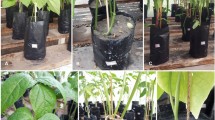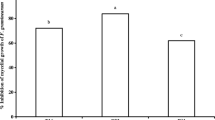Abstract
Each of 12 cultures ofFusarium, comprising four species, isolated from moldy soybeans suspected of being involved in illness of wild geese, were grown separately in autoclaved moist rice, in autoclaved moist soybeans, and in surface sterilized-disinfected soybeans, assayed for various mycotoxins, and fed to rats. Four additional cultures that produced known toxins on rice were also grown on soybeans as controls. All isolates, except one ofF moniliforme, grown in rice resulted in weight loss of rats, and that one resulted in weight gain; 12 of the isolates caused death. One isolate ofF poae grown in soybeans caused death when consumed by rats, but none of the other 15 resulted in weight loss or overt injury. Much larger amounts of zearalenone, deoxynivalenol (DON), T-2 toxin, neosolaniol, T-2 tetraol, wortmannin, and moniliformin were produced by the cultures on rice than on soybeans, but more HT-2 toxin was produced by one isolate ofF poae grown on soybeans than when grown on rice. Soybeans appear to be a poor substrate for elaboration of most of the toxins produced by the isolates tested.
Similar content being viewed by others
Reference
Abbas HK, Mirocha CJ, Shier WT (1984) Mycotoxins produced from fungi isolated from foodstuffs and soil: comparison of toxicity in fibroblasts and rat feeding tests. Appl Environ Microbiol 48:654–661
Abbas HK, Mirocha CJ, Tuite J (1986) Natural occurrence of deoxynivalenol, 15 — acetyldeoxynivalenol and zearalenone in refusal factor corn stored since 1972. Appl Environ Microbiol 51:841–843
Abbas HK, Mirocha CJ (1985) Production of moniliformin byFusarium moniliforme varsubglutinans isolated from wheat kernels originating in Minnesota. Microbiologie Aliments Nutrition 3:223 – 227
Abbas HK, Mirocha CJ (1988) Isolation and purification of a hemorrhagic factor (wortmannin) fromFusarium oxysporium (N17B). Appl Environ Microbiol 54: 1268–1274
Badawey A, Halasz A, Sawinsky J, Kozma E (1987) Influence of substrate on the F-2 and T-2 production ofFusarium species. Acta Alimentaria 16:29–43
Bennett GA, Shotwell OL, Kwolek WF (1985) Liquid chromatographic determination of zearalenol and zearalenone in corn: collaborative study. J Assoc Off Anal Chem 68:958–961
DeVries JW, Chang HL (1982) Comparison of rapid high pressure liquid chromatographic and CB methods for determination of aflatoxins in corn and peanuts. J Assoc Off Anal Chem 65:206–209
Eugenio CP, Christensen CM, Mirocha CJ (1970) Factors affecting production of the mycotoxin F-2 byFusarium roseum. Phytopathology 60:1055–1057
Hsu IC, Smalley EB, Strong FM, Ribeline WE (1972) Identification of T-2 toxin in moldy corn associated with a lethal toxicosis in dairy cattle. Appl Environ Microbiol 24:684–690
Jacobsen BJ, Harlin KS, Swanson SP, Sinclair JB (1988) Occurrence of fungi and mycotoxins associated with field mold damaged soybeans in Illinois. Phytopathology (Abstr) 78:1618
Marasas WFO, Nelson PE, Toussoun TA (1984) ToxigenicFusarium Species. Pennsylvania State University Press, University Park, 328 pp
Nelson PE, Toussoun TA, Marasas WFO (1983)Fusarium species (an illustrated manual for identification), pp 1–193. The Pennsylvania State University Press, University Park
Nik WZ (1980) Seed borne fungi of soybean [Glycine max (L) Merril] and their control. Pertanika 3:125–132
Richardson KE, Hagler WM, Jr, Haney CA, Hamilton PB (1985) Zearalenone and trichothecene production in soybeans by toxigenicFusarium. J Food Protec 48:240–243
Romer TR (1986) Use of small charcoal / alumina cleanup columns in determination of trichothecene mycotoxins in foods and feeds. J Assoc Off Anal Chem 69:699–703
Scott PM, Lawrence GA (1987) Liquid chromatographic determination and stability of theFusarium mycotoxin moniliformin in cereal grains. J Assoc Off Anal Chem 70:850–853
Thiel PG, Meyer JC, Marasas WFO (1982) Natural occurrence of moniliformin together with deoxynivalenol and zearalenone in Transkeian corn. J Agric Food Chem 30:308–312
Vaamonde G, Scarmato G, Bonera N (1987) Zearalenone production byFusarium species isolated from soybeans. International J Food Microbiol 4:129–133
Wicklow DT, Bennett GA, Shotwell OL (1987) Secondary invasion of soybeans byFusarium graminearum and resulting mycotoxin contamination. Plant Disease 71:1146
Author information
Authors and Affiliations
Rights and permissions
About this article
Cite this article
Abbas, H., Bosch, U. Evaluation of trichothecene and nontrichothecene mycotoxins produced byFusarium in soybeans. Mycotox Res 6, 13–20 (1990). https://doi.org/10.1007/BF03192134
Received:
Accepted:
Issue Date:
DOI: https://doi.org/10.1007/BF03192134




